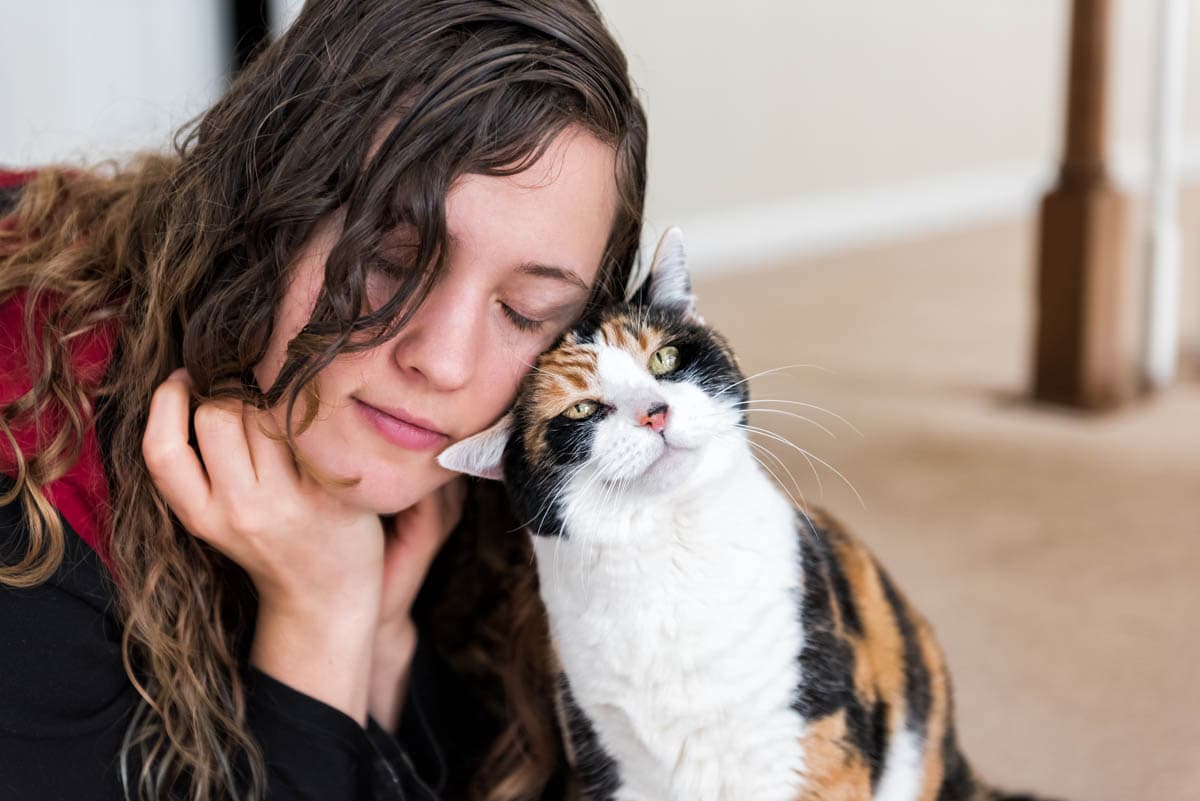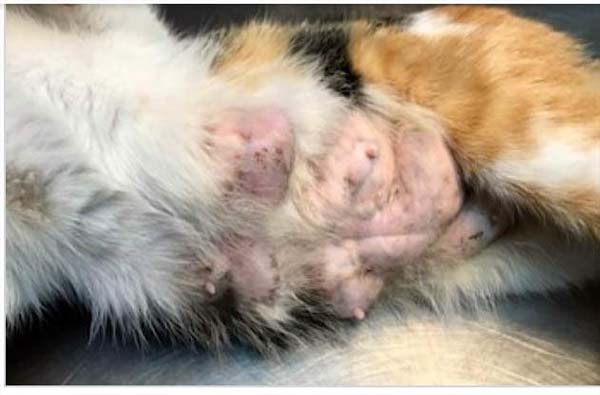Cancer of any kind can be extremely debilitating for a cat. When your precious kitty has cancer, one of the hardest decisions you’ll make is when to euthanize her. How will you know it’s time to humanely end your cat’s suffering?
In this article, we’ll provide a list of questions for you to consider if you’re wrestling with this difficult decision. We’ll discuss signs that may tell you it’s time to say goodbye to your beloved cat and how to care for her when it’s too soon to consider euthanasia.

Key questions to ask yourself before euthanizing a cat with cancer
Some questions you should consider when you’re wondering if it’s time to euthanize your cat include:
1. What type of cancer does my cat have?
Your cat’s life expectancy and prognosis will vary depending on the type of cancer she has. For example, lymphoma or sarcoma in cats has good prognosis when they’re diagnosed and treated early. On the other hand, mammary carcinomas and squamous cell carcinomas tend to metastasize and have poorer prognoses once cancer spreads to other parts of the body.
2. What is my cat’s quality of life with cancer?
Consider what good and bad days look like for your kitty. What does she typically do in a day? Observe whether your cat is active or just seems to be surviving. Do the good days outnumber the bad days or vice versa? Consider keeping a log to track her daily life. Ask yourself these questions:
- Is my cat in pain which can’t be controlled well with pain medicine?
- Is my cat able to eat and drink without help?
- Is my cat able to pee and poop without regular assistance?
- Can my cat move around? Come over for a cuddle?
- Does my cat find enjoyment in food/toys/treats/cuddles… anything?
- Is my cat scared, anxious, or confused most of the time?
- Does my cat take comfort from being around you, or at home, or is she oblivious?
- Does my cat participate in life in any way, or is she just ‘existing’?
3. How is my cat responding to treatment?
If your cat is receiving supportive care or therapy, how is it affecting her behavior and quality of life? If your kitty continues to decline despite treatment, it may be time to consider euthanasia.
4. What is my cat’s life expectancy with cancer?
Knowing how much longer your cat is expected to live can help you decide when it’s time to talk about putting her down. Life expectancy is often tied to the stage of cancer. When the disease is diagnosed and treated early, cats are more likely to survive and live for many years. Conversely, advanced stages of cancer usually indicate a short life expectancy.
5. Does my cat have other health conditions that affect her quality of life?
If your kitty has concurrent diseases such as kidney or heart disease, they may not be able to handle cancer treatments. Underlying conditions can also magnify the effects of cancer so that your kitty deteriorates more rapidly.
Will my cat suffer when she’s put to sleep?
Fortunately, euthanasia is usually pain-free after the veterinarian injects a mild sedative. Under professional care, your kitty should pass away peacefully.
Should I let my cat die naturally?
Cancer can be painful in the later stages. Letting your kitty die naturally may expose her to unneeded suffering. If her cancer is not responding to treatments, euthanasia is the humane option.
When to euthanize your cat with cancer – key physical signs that it’s time
It may be time to consider an end of life when your cat’s quality of life continues to decline despite treatment. Some key physical signs you can watch for when you’re deciding whether it’s time to euthanize your cat include:
1. Loss of appetite
A poor appetite is an early indicator that your cat’s quality of life is declining. If your cat is refusing to eat, you may want to try feeding her tuna, sardines, or chicken baby food to encourage her. If there’s no change in your cat’s interest in food after 1-2 days, take her to the vet. You can also talk with your veterinarian about a prescription appetite stimulant such as Mirtazapine. Always follow your vet’s instructions with prescription medications.
2. Difficulty breathing
End-stage cancer can affect other body systems including the lungs. If your cat has difficulty breathing, it may point to fluid buildup in the lungs from pulmonary edema. This condition can contribute to a loss of appetite and other conditions.
3. Sudden changes in personality
When your cat’s health is declining rapidly, she may exhibit changes in behavior. She may act completely different from normal such as hiding instead of being friendly or suddenly becoming very clingy.
4. Weakness and weight loss
Cancer cells grow rapidly and need energy. As a result, the nutrients your cat takes in are diverted to fuel the tumors. With advanced cancers, cats lose muscle mass, lose weight, and become weak and lethargic.
5. Pain symptoms
In the later stages, cancer can cause a lot of pain. If your kitty seems unwilling to move or jump, is crying or making other unusual vocalizations, or shows changes in elimination behavior, it may indicate she’s in pain.
6. Other signs
When cancer takes a general toll on the body systems, you may notice signs such as:
- Difficulty eating, dropping food or salivating
- Difficulty urinating
- Difficulty defecating or constipation
How the decision to euthanize your cat can vary by cancer type
Various types of cancer can develop in cats. Depending on the affected organs or body systems, the symptoms, prognosis, and life expectancy can differ. Understanding the symptoms, quality of life, and life expectancy of your cat’s cancer can help you make an informed decision.
1. Mouth cancer & euthanasia decision
A vast majority (about 80%) of mouth cancers in cats are due to squamous cell carcinoma. Cats that get this disease have a poor prognosis because it’s usually not diagnosed until the cancer is in its advanced stages. Squamous cell carcinoma of the mouth causes significant pain in cats. Owners usually notice:
- Bad breath
- Drooling or difficulty eating
- Facial swelling
- Loss of teeth
- Weight loss
Mouth tumors usually occur in cats over about 10 years old, but they can affect younger felines. Treatment mainly aims at improving quality of life and extending life expectancy. The best results occur when the tumors can be surgically removed. Life expectancy after diagnosis is usually 1 ½ to 3 months.
2. Mammary cancer: when it is time to put your cat to sleep

Mammary tumors are about 95% more common in female cats than in toms. The prognosis varies depending on the size of the tumors and how quickly they are diagnosed and treated. Usually, the tumors are malignant adenocarcinomas that tend to metastasize to other body organs. Early diagnosis and aggressive treatment are key to extending your cat’s life expectancy.
In the early stages of mammary cancer, the lesions aren’t painful, and you may not notice them unless you routinely palpate your cat’s abdomen. Later, tumors can ulcerate causing pain, inflammation, and excessive grooming. Surgical removal with or without chemotherapy is the preferred treatment. Prognosis and life expectancy are mainly based on the tumor size:
- Cats with tumors > 3 cm in diameter survive an average of 4-6 months.
- Cats with tumors 2-3 cm in diameter survive an average of 2 years.
- Cats with tumors < 2 cm in diameter survive greater than 3 years on average.
3. Nasal cancer & the euthanasia decision
Although rare in cats, nasal tumors occur primarily in older felines. When they happen, they may be caused by carcinomas, sarcomas, or lymphomas. In the early stages, owners may notice:
- Nasal or ocular discharge from one or both sides
- Excessive phlegm
- Loose teeth
- Pawing at the face
- Nosebleeds
- Respiratory sounds
- Loose teeth
In later stages, owners may notice facial deformity and bone lysis. If the mass expands into the brain, cats usually have seizures and exhibit behavioral changes.
The prognosis for nasal cancer is poor regardless of etiology. Treatment usually involves radiation and chemotherapy. Survivability for cats with nasal tumors is usually 2-7 months without treatment. With treatment, 40-80% of cats survive the first year of treatment.
4. Lung Cancer & putting your cat to sleep
Primary lung cancer in cats is fairly rare and usually occurs in older cats. Most lung tumors(80%) are malignant and likely to spread to other parts of the body. Signs of lung cancer vary depending on the location of the tumor, the presence or absence of other lung conditions, and the growth rate of the tumor. Owners may notice:
- With loss
- Poor appetite
- Difficulty breathing/rapid breaths
- Wheezing
- Lethargy
In later stages, the signs may include:
- Vomiting
- Fever
- Lameness/swollen limbs
- Malaise
If your cat has a single tumor, the affected lung lobe can be surgically removed. Otherwise, radiation and chemotherapy may slow the disease progression or possibly cause remission. The prognosis and life expectancy vary depending on the stage of cancer. Cats may live about a year after the removal of a solitary tumor if there’s no metastasis. When cancer spreads to the regional lymph nodes, the life expectancy is a few months.
5. Bladder cancer & euthanasia decision
Bladder cancer in cats is a life-threatening disease that’s usually found in females when they’re around 7 years old. Most commonly a transitional cell carcinoma, bladder cancer is fast-growing and tends to metastasize. The signs of bladder cancer include:
- Straining to urinate/defecate
- Crying while urinating
- Increased frequency of urination with dribbling
- Urethral obstruction
- Polydipsia(drinking excessively)
- Exercise intolerance
- Difficulty breathing
- Coughing
- Anorexia
- Weight loss
The treatment for bladder cancer depends on the location and stage of the tumor. Surgery is recommended only if the tumor is small and in the body of the bladder. When surgery is not a viable option, veterinarians usually use chemotherapy and symptomatic treatment. The survival rate of cats with bladder cancer ranges anywhere from a few weeks to about a year.
6. Lymphoma
Feline lymphoma in cats can occur anywhere in the body but is usually associated with lymph nodes. Gastrointestinal lymphoma is the most common form. Cats infected with FIV are 5.6 times more likely to develop this cancer. Signs of lymphoma include:
- Anorexia
- Weight loss
- vomiting/diarrhea
- Anemia/pale gums
- Poor coat/skin condition
- Lumps
The prognosis and life expectancy of cats with lymphoma depend on the location and stage of the lymphoma and the treatment approach. Sometimes, isolated tumors that are caught early can be surgically removed and never grow back. When lymphoma can’t be surgically treated, it usually responds well to chemotherapy and radiation therapy. Cats that receive chemotherapy and radiation treatments can live for 2 or more years. Untreated felines rarely last beyond 1-3 months.
How to make the decision to euthanize a cat with cancer
You want the best for your beloved cat, but it can be hard to know when it’s time to consider euthanasia. It’s a difficult and emotional decision. Truly, there’s not a clear right or wrong choice because every cat is different. However, you can consider several factors and consult with your veterinarian to help you make the best decision for your situation.
Some signs that it’s time to say goodbye to your feline furbaby include:
-
- Loss of appetite – when your cat loses her desire to eat, it may mean her quality of life is deteriorating.
- Poor quality of life – your cat’s bad days are more numerous than her good days
- Worsening symptoms – your kitty’s symptoms are not responding to treatment but increasing in severity
- Difficulty breathing – trouble breathing may mean there’s fluid collecting in the lungs and can contribute to more health complications
- Age or concurrent disease – elderly cats or felines with other diseases often have weakened systems and may have a significantly shorter life expectancy
- Change in behavior – a sudden change in your cat’s behavior may indicate that her health is rapidly declining
- Extreme weight loss – cancer cells consume energy and nutrients that the body needs causing weight loss and muscle wasting
If you decide it’s time to end your cat’s life, know that euthanasia won’t be painful for your kitty. Your veterinarian will make every effort to keep your cat calm and comfortable during the procedure. You will be able to choose whether or not you remain with your cat during the process.
Signs that it may be too early to euthanize your cat
Quality of life is a key indicator that can help you make the difficult decision of whether or not to euthanize your cat. Indicators that your furbaby isn’t ready for euthanasia include:
- Appetite – your cat is still eating or is willing to eat with gentle coaxing
- Hydration – your cat is consuming enough fluids to stay well-hydrated
- Happiness – your cat continues to show interest in play and other activities
- Mobility/pain – your cat can use the litter box and move without assistance
- Energy – your cat is still active and not showing signs of depression or lethargy
How to care for a cat with cancer when you’re not ready to euthanize
Because deciding to euthanize your cat is difficult, it may take you some time to take the final step. In the interim, you’ll need to provide care and do everything you can to minimize your furbaby’s discomfort

- Learn everything you can about your cat’s cancer and treatment options
- Work closely with your veterinarian to provide appropriate supportive care
- Keep a familiar routine for your cat
- Track your cat’s behavior and activity patterns so you know when things change
- Maintain nutrition by feeding readily digestible foods and encouraging eating
- Groom your cat every day if she’s not doing it herself
- If needed, relocate bedding, food, and water dishes to make eating, drinking, and sleeping as comfortable and painless as possible
- If your kitty is weakened by cancer treatments, turn and massage her periodically to stimulate circulation in the limbs
- Provide plenty of TLC and affection
